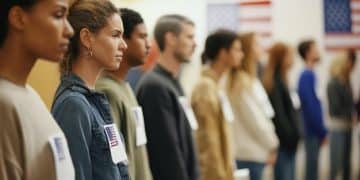Voter ID Laws and Minority Turnout: Analyzing the Impact

Analyzing the impact of voter ID laws on minority turnout involves examining statistical data and research to determine how these laws affect the participation of different racial and ethnic groups in elections, sparking a debate over voter suppression versus election integrity.
The debate surrounding voter identification (ID) laws in the United States is complex and deeply rooted in questions of social justice and democratic access. Central to this conversation is analyzing the impact of voter ID laws on minority turnout, a crucial factor for ensuring equitable and representative elections.
Understanding Voter ID Laws and Their Evolution
Voter ID laws require voters to present identification at the polls before casting their ballots. These laws vary significantly by state, ranging from strict photo ID requirements to allowing non-photo identification or alternatives like signing an affidavit. To understand the current debate, it’s important to examine the historical context and the evolution of these laws.
Historical Context of Voter ID Laws
The history of voter ID laws in the U.S. is intertwined with efforts to regulate and, at times, suppress voting. Following the Civil War, many Southern states implemented measures like poll taxes and literacy tests to disenfranchise Black voters. While the Voting Rights Act of 1965 aimed to eliminate such discriminatory practices, debates over voter ID have persisted, often framed around concerns of voter fraud.
Types of Voter ID Laws
Voter ID laws can be broadly categorized into strict and non-strict. States with strict photo ID laws require voters to present specific government-issued photo identification, such as a driver’s license or passport. Non-strict laws may allow voters to use alternative forms of ID, like utility bills or bank statements, or to sign an affidavit if they lack acceptable identification.

- Strict Photo ID Laws: Voters must present an approved photo ID, or they may not be able to vote.
- Non-Strict Photo ID Laws: Voters without an approved photo ID can often vote by signing an affidavit or using a provisional ballot.
- Non-Photo ID Laws: Voters can present non-photo identification, such as a utility bill or bank statement.
The evolution of these laws reflects ongoing debates about balancing election security with voter access, with different states adopting different approaches based on their political contexts and priorities. The impact of these varying laws on minority turnout is a key area of research and contention.
Analyzing the Data: Voter ID and Minority Turnout
Data on voter turnout is a crucial component of analyzing the true effects of voter ID laws. This data, often complicated and sometimes contradictory, has been examined by academics, advocacy groups, and government entities in an attempt to determine the true consequences of such legislation.
Key Studies on Voter ID and Turnout
Numerous studies have examined the relationship between voter ID laws and turnout among minority groups. Some research suggests that strict photo ID laws can decrease turnout among racial and ethnic minorities, particularly those with lower incomes or limited access to transportation. Other studies, however, argue that the impact is minimal or non-existent, attributing variations in turnout to other factors like voter mobilization efforts or election-specific dynamics.
Challenges in Data Analysis
Analyzing the impact of voter ID laws on minority turnout is not without its challenges. Many factors can influence voter participation, and isolating the specific effect of ID requirements can be difficult. These factors include socioeconomic status, education levels, access to transportation, and the intensity of voter outreach efforts. Additionally, variations in the implementation and enforcement of voter ID laws across different states and counties can further complicate data analysis.
Despite the difficulties in getting clear statistics, this research is critical to understanding how ID laws affect various demographics. To make sure elections are fair and accessible to everyone, legislators and decision-makers need to be able to rely on facts.
The Debate: Voter Suppression vs. Election Integrity
The debate surrounding voter ID laws often boils down to two competing principles: preventing voter fraud and ensuring that every eligible citizen has the ability to exercise their right to vote. Each side argues for what they view as essential to a fair and democratic process.
Arguments for Voter ID Laws
Proponents of voter ID laws argue that they are necessary to prevent voter fraud and maintain the integrity of elections. They contend that requiring identification at the polls can deter impersonation fraud and ensure that only eligible voters cast ballots. Supporters also suggest that voter ID laws can increase public confidence in the electoral process and reduce the potential for contested election outcomes.
Arguments Against Voter ID Laws
Opponents of voter ID laws argue that they disproportionately burden minority voters and those with lower incomes, who may have difficulty obtaining the required identification. They point to studies showing that strict photo ID laws can decrease turnout among these groups, effectively disenfranchising eligible voters. Critics also argue that voter fraud is rare, and that voter ID laws are a solution in search of a problem, designed more to suppress turnout than to prevent fraud.

- Voter Fraud Concerns: Advocates emphasize the need to prevent fraudulent voting practices.
- Disenfranchisement Risks: Opponents highlight the potential for voter ID laws to disenfranchise eligible voters.
- Equality and Access: The debate centers on whether voter ID laws promote election integrity or restrict access to the ballot box.
The debate over voter ID laws highlights the complex tension between election security and voter access. Finding a balance that upholds both principles is a critical challenge for policymakers as they seek to ensure fair and representative elections.
Specific Challenges Faced by Minority Voters
Minority voters often face specific challenges that can be exacerbated by voter ID laws. These challenges include socioeconomic barriers, limited access to transportation, and historical patterns of discrimination that may create distrust of the electoral system.
Socioeconomic Factors
Socioeconomic factors can play a significant role in a voter’s ability to obtain the required identification. Obtaining a government-issued photo ID often requires documentation like a birth certificate, which can be costly and difficult to acquire for individuals with limited resources. Additionally, the cost of transportation to a DMV or other issuing agency can be a barrier for low-income voters.
Access to Transportation and DMV Locations
Access to transportation and convenient DMV locations can also pose challenges for minority voters, particularly in rural areas or communities with limited public transportation options. Many minority voters may rely on public transportation or lack access to a personal vehicle, making it difficult to travel to a DMV to obtain the necessary identification. Additionally, DMV locations may be limited in certain areas, requiring voters to travel long distances or wait in long lines.
Understanding such challenges is key to address any unintentional barriers to voting. Laws developed with a lack of consideration for these issues can cause disenfranchisement among already marginalized communities.
The Role of Education and Outreach Programs
Effective education and outreach programs are essential for mitigating the potential negative impacts of voter ID laws on minority turnout. These programs can help ensure that all eligible voters are aware of the requirements and have the resources to comply with them.
Community-Based Initiatives
Community-based initiatives play a crucial role in informing and assisting minority voters with voter ID requirements. Local organizations, churches, and community centers can conduct voter education workshops, provide transportation to DMV locations, and help individuals obtain the necessary documentation to acquire identification. These initiatives can also build trust within communities and encourage voter participation.
Government and Non-Profit Partnerships
Partnerships between government agencies and non-profit organizations can enhance voter education and outreach efforts. Government agencies can provide funding and resources to support community-based initiatives, while non-profit organizations can leverage their expertise and community connections to reach minority voters. These partnerships can also ensure that voter education materials are accurate, culturally sensitive, and accessible to all voters.
These initiatives are essential in the effort to close the knowledge gap and lessen the hurdles facing minority voters. By empowering voters with correct information and support, these initiatives advance electoral involvement and preserve democratic values.
Potential Reforms and Solutions
Addressing the concerns raised by both sides of this vigorous debate requires serious thought, and exploring reforms and prospective solutions is a must. Finding common ground can greatly increase the integrity of elections while maintaining equality of access for people from every background.
Alternative Forms of Identification
One potential solution is to expand the types of identification accepted at the polls to include non-photo identification, such as utility bills or bank statements. This approach can reduce the burden on voters who have difficulty obtaining a government-issued photo ID while still ensuring some level of verification. However, some argue that non-photo identification is less secure and more susceptible to fraud.
Automatic Voter Registration
Automatic voter registration (AVR) is another reform that could potentially increase voter turnout among minority groups. Under AVR, eligible citizens are automatically registered to vote when they interact with government agencies, such as the DMV. This approach can streamline the registration process and reduce barriers to participation, particularly for individuals who may not be aware of voter registration deadlines or requirements.
| Key Point | Brief Description |
|---|---|
| 🆔 Voter ID Laws | Laws requiring voters to present identification at the polls. |
| 📊 Data Analysis | Studies on the impact of voter ID laws on minority turnout can be challenging and contradictory. |
| 🤝 Education Programs | Community and government initiatives provide resources and assistance to minority voters. |
| 🗳️ Potential Reforms | Alternative IDs and automatic voter registration are possible solutions. |
Frequently Asked Questions
▼
Voter ID laws are regulations that require a person to show some form of identification in order to vote. These laws vary by state, ranging from strict photo ID requirements to allowing non-photo identification.
▼
The controversy stems from debates over election integrity versus voter suppression. Proponents argue they prevent fraud, while opponents say they disproportionately affect minority and low-income voters who may lack required ID.
▼
Studies suggest that strict voter ID laws can decrease minority turnout. Minority voters may face challenges such as limited access to transportation, documentation costs, and historical distrust, making it harder to obtain necessary IDs.
▼
Possible solutions include expanding acceptable forms of ID to include non-photo options like utility bills, implementing automatic voter registration, and increasing community outreach and education programs.
▼
Increasing voter turnout involves reducing barriers to registration and voting, improving voter education, and ensuring accessible polling locations. Addressing socioeconomic factors and historical distrust is also crucial for engagement.
Conclusion
In conclusion, analyzing the impact of voter ID laws on minority turnout remains a complex and contested issue. While proponents advocate for voter ID laws as a means to enhance election integrity, opponents express concerns about potential voter suppression. Addressing this debate requires a balanced approach that considers both the need for secure elections and the importance of ensuring equal access to the ballot box for all citizens. By implementing evidence-based policies, promoting voter education, and addressing the specific challenges faced by minority voters, we can work towards a more inclusive and equitable democratic process.





